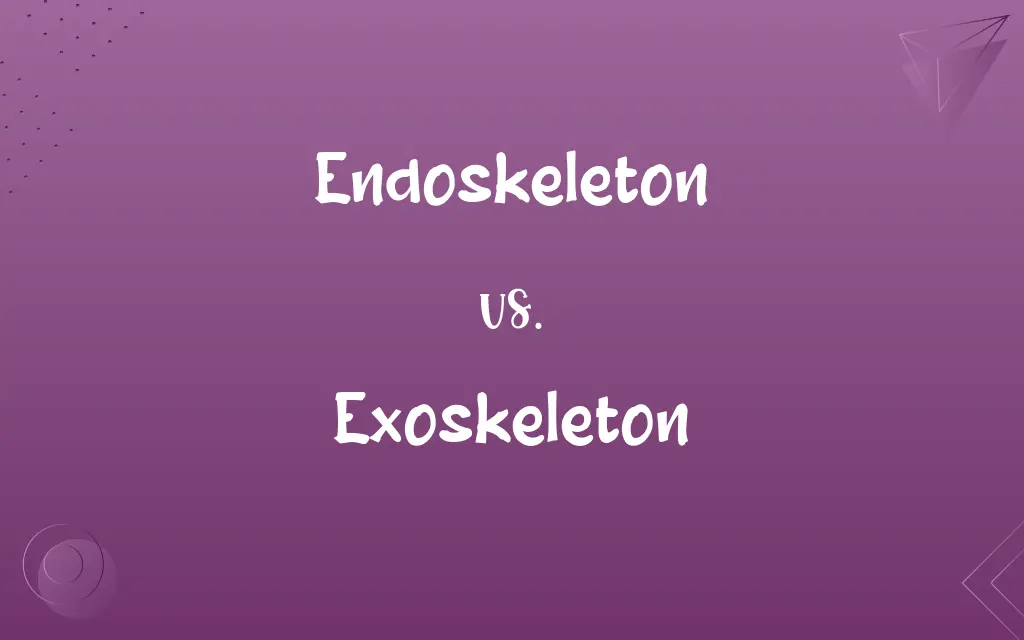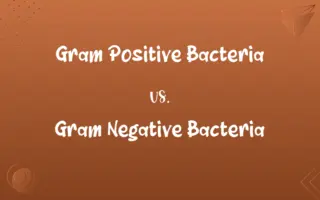Endoskeleton vs. Exoskeleton: Know the Difference

By Shumaila Saeed || Updated on December 25, 2023
Endoskeleton is an internal skeleton supporting an organism's body, while Exoskeleton is an external skeleton protecting and supporting an organism's body.

Key Differences
Endoskeletons are internal frameworks found within the body, providing support and facilitating movement, primarily seen in vertebrates. Exoskeletons, in contrast, are external structures that cover the body, offering protection and support, commonly found in insects and crustaceans.
Shumaila Saeed
Dec 17, 2023
The composition of an endoskeleton is typically bone or cartilage, which allows for growth and adaptability in vertebrates. Exoskeletons are made of rigid materials like chitin or calcium carbonate, providing a tough protective layer for invertebrates.
Shumaila Saeed
Dec 17, 2023
Endoskeletons enable organisms to grow in size by continuous internal development and remodeling. Exoskeletons, however, necessitate molting for the organism to grow, as their rigidity does not allow for expansion.
Shumaila Saeed
Dec 17, 2023
In endoskeletons, muscle attachment is internal, facilitating diverse and complex movements. In exoskeletons, muscles attach to the inside of the external skeleton, which can limit mobility but offer better protection.
Shumaila Saeed
Dec 17, 2023
Endoskeletons are generally found in larger, more complex organisms like mammals and birds, supporting their size and weight. Exoskeletons are more common in smaller organisms like insects and crustaceans, providing them with essential structural support and defense against predators.
Shumaila Saeed
Dec 17, 2023
ADVERTISEMENT
Comparison Chart
Location
Internal, within the organism’s body
External, covering the organism’s body
Shumaila Saeed
Dec 17, 2023
Composition
Bone or cartilage
Chitin, calcium carbonate, or similar materials
Shumaila Saeed
Dec 17, 2023
Growth Accommodation
Allows continuous growth internally
Requires molting for growth
Shumaila Saeed
Dec 17, 2023
Commonly Found In
Vertebrates (mammals, birds, reptiles)
Invertebrates (insects, crustaceans)
Shumaila Saeed
Dec 17, 2023
ADVERTISEMENT
Endoskeleton and Exoskeleton Definitions
Endoskeleton
The internal bone or cartilage structure in vertebrates.
Fish have an endoskeleton made primarily of bone.
Shumaila Saeed
Dec 11, 2023
Exoskeleton
A protective and supportive outer shell in certain animals.
The exoskeleton of a lobster is both strong and flexible.
Shumaila Saeed
Dec 11, 2023
Endoskeleton
An inner skeleton, characteristic of vertebrate animals.
Birds' lightweight endoskeleton allows for flight.
Shumaila Saeed
Dec 11, 2023
Exoskeleton
A rigid external covering for the body in some invertebrates.
A crab's exoskeleton provides protection from predators.
Shumaila Saeed
Dec 11, 2023
Endoskeleton
A skeletal system housed within the organism’s body.
The human spine is a crucial part of the endoskeleton.
Shumaila Saeed
Dec 11, 2023
ADVERTISEMENT
Exoskeleton
The outer protective layer found in many invertebrates.
The shrimp has a calcified exoskeleton.
Shumaila Saeed
Dec 11, 2023
Endoskeleton
A supportive framework within the body of an organism.
The human endoskeleton includes bones that protect vital organs.
Shumaila Saeed
Dec 11, 2023
Exoskeleton
A hard outer structure that provides form and protection in organisms.
The exoskeleton of a beetle is made of chitin.
Shumaila Saeed
Dec 11, 2023
Endoskeleton
The internal structure providing form and support in animals.
The endoskeleton of mammals varies greatly in size and shape.
Shumaila Saeed
Dec 11, 2023
Exoskeleton
The external skeleton that supports and protects an animal's body.
Insects shed their exoskeleton to grow, a process known as molting.
Shumaila Saeed
Dec 11, 2023
Endoskeleton
An internal supporting skeleton, derived from the mesoderm, that is characteristic of vertebrates and certain invertebrates.
Shumaila Saeed
Dec 08, 2023
Exoskeleton
A hard outer structure, such as the shell of an insect or crustacean, that provides protection or support for an organism.
Shumaila Saeed
Dec 08, 2023
Endoskeleton
(anatomy) The internal skeleton of an animal, which in vertebrates is composed of bone and cartilage.
Shumaila Saeed
Dec 08, 2023
Endoskeleton
The bony, cartilaginous, or other internal framework of an animal, as distinguished from the exoskeleton.
Shumaila Saeed
Dec 08, 2023
Exoskeleton
(anatomy) A hard outer structure that provides both structure and protection to creatures such as insects and Crustacea.
Shumaila Saeed
Dec 08, 2023
Endoskeleton
The internal skeleton; bony and cartilaginous structure (especially of vertebrates)
Shumaila Saeed
Dec 08, 2023
Exoskeleton
The hardened parts of the external integument of an animal, including hair, feathers, nails, horns, scales, etc.,as well as the armor of armadillos and many reptiles, and the shells or hardened integument of numerous invertebrates; external skeleton; dermoskeleton.
Shumaila Saeed
Dec 08, 2023
Exoskeleton
The exterior protective or supporting structure or shell of many animals (especially invertebrates) including bony or horny parts such as nails or scales or hoofs
Shumaila Saeed
Dec 08, 2023
Repeatedly Asked Queries
How does an endoskeleton support the body?
It provides internal structure and attachment points for muscles.
Shumaila Saeed
Dec 17, 2023
Which animals have an endoskeleton?
Vertebrates like mammals, birds, reptiles, and fish.
Shumaila Saeed
Dec 17, 2023
What is an exoskeleton?
A rigid external covering for the body in some invertebrates.
Shumaila Saeed
Dec 17, 2023
Can endoskeletons grow with the organism?
Yes, they grow and adapt with the organism.
Shumaila Saeed
Dec 17, 2023
Which animals have an exoskeleton?
Invertebrates like insects, crustaceans, and arachnids.
Shumaila Saeed
Dec 17, 2023
How does an exoskeleton protect an organism?
It offers a hard outer layer that protects against physical damage and predators.
Shumaila Saeed
Dec 17, 2023
What is an endoskeleton?
An internal skeleton within an organism, typically made of bone or cartilage.
Shumaila Saeed
Dec 17, 2023
What material forms the human endoskeleton?
Mostly bone and some cartilage.
Shumaila Saeed
Dec 17, 2023
Do endoskeletons offer protection like exoskeletons?
They provide some protection, especially to vital organs.
Shumaila Saeed
Dec 17, 2023
Do organisms with exoskeletons need to molt?
Yes, they must shed their exoskeleton to grow.
Shumaila Saeed
Dec 17, 2023
What happens to an exoskeleton during molting?
The organism sheds its old exoskeleton to grow a new, larger one.
Shumaila Saeed
Dec 17, 2023
What materials make up an exoskeleton?
Chitin, calcium carbonate, or similar substances.
Shumaila Saeed
Dec 17, 2023
Are exoskeletons common in larger animals?
No, they are more common in smaller invertebrates.
Shumaila Saeed
Dec 17, 2023
Is the human skeleton an endoskeleton?
Yes, it is an internal structure made of bones.
Shumaila Saeed
Dec 17, 2023
Are there any disadvantages to having an endoskeleton?
They are less protective against external forces compared to exoskeletons.
Shumaila Saeed
Dec 17, 2023
How do muscles attach in organisms with endoskeletons?
Muscles attach internally to the bones.
Shumaila Saeed
Dec 17, 2023
How do muscles work with exoskeletons?
Muscles attach to the inside of the exoskeleton.
Shumaila Saeed
Dec 17, 2023
Are exoskeletons flexible?
Generally, they are rigid, but some have flexible joints.
Shumaila Saeed
Dec 17, 2023
Can endoskeletons repair themselves?
Yes, bones can heal and regenerate to some extent.
Shumaila Saeed
Dec 17, 2023
Do endoskeletons or exoskeletons allow for better mobility?
Endoskeletons generally allow for greater mobility.
Shumaila Saeed
Dec 17, 2023
Share this page
Link for your blog / website
HTML
Link to share via messenger
About Author
Written by
Shumaila SaeedShumaila Saeed, an expert content creator with 6 years of experience, specializes in distilling complex topics into easily digestible comparisons, shining a light on the nuances that both inform and educate readers with clarity and accuracy.









































































